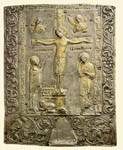|
|
| Byzantine Minor Arts |
11th-12th c. and 1758 Protaton Silver gilt, with repoussι work 17.8 x 14.2 x 1.2 cm |
|

|
To the cover of this silver gilt staurotheke has been added a rectangular tablet made of a single sheet of silver and decorated in repoussι work with the Crucifixion. The long sides have bands with sinuous, twining tendrils, while at the bottom two flora volutes with leaves and fruit frame a plain, undecorated triangle. These bands belong to the staurotheke which, according to the inscription running around it, was offered by monks from various kellia to the 'great church of the Protaton' in 1758 (Millet - Pargoire - Petit 1904, no. 26, p. 10). The compartment with the scene of the Crucifixion was also donated, according to its inscription, by a monk named Zosimas, who is pictured kneeling in adoration at the feet of the Virgin. Above him is the inscription in five lines: '+ Κ(υρι)Ε ΒΟΗ/ΘΕΙ Ζω/CΙΜΑ ΜΟΝΑ/Χω' (Lord, be with the monk Zosimas); while in the margins of the compartment, again in majuscules, written with a double incision and beginning on the top and continuing down the sides (first right, then left), is the inscription: 'ΤΟΥC ΖωΟΠΟΙΟΥC ΕΚ ΤΟΠωΝ CΕΒΑCΜΙωΝ/ ΠΙΣΤΕΙ ΖΕΟΥCΗ ΖωCΙΜΑC ΠΛΟΥΤΕΙ ΛΙΘΟΥΣ/ ΚΟCΜΕΙ ΔΕ ΝΙΚΟΛΑΟC ΤΗΝ ΘΗΚΗΝ ΠΟΘω', which tells us that the decoration was executed by a man named Nikolaos. Beneath the horizontal arm of the Cross, in characters similar to those in the first Zosimas' inscription, are the inscriptions 'Here is your son' - 'Here is your mother' (John 19:26-27). The letters composing the text of the inscription are comparable in form to those on an eleventh-century staurotheke in the Musιe du Louvre and a late eleventh- to twelfth-century one in the Hermitage (Byzance 1992, no. 237, pp. 322-3. Bank 1985, nos. 205-6), which as we shall see also display other similarities in iconography and style. This staurotheke, like so many others (Byzance 1992, nos. 236-7, pp. 321-2), has obviously been assembled from elements belonging to different periods. The tablet with the Crucifixion and parts of the strips with stones from the Holy Land in the interior of the reliquary belong to the original Byzantine staurotheke. These strips are framed by a rosetted band, which has been unevenly cut away in order to create a window to display the later reliquary, which contains fragments of the True Cross. The characters in the inscription telling of the provenance of the stones are the same as those in the lateral inscriptions, that is, with double incisions and a form found in metalwork from the tenth-eleventh centuries (Splendori di Bisanzio 1993, no. 68, p. 176) and the fourteenth-fifteenth centuries (see below, no. 9.20). Iconographically and stylistically, the composition of the Crucifixion finds its closest parallels in tenth-, eleventh- and twelfth-century ivories, steatites and silver gilt works (Bank 1985, nos. 205-6. Byzance 1992, no. 237, pp. 322-3. Byzantium 1994, no. 153, pp. 142-3. Kalavrezou-Maxeiner 1985, no. 77, pp. 168-9 and 45, pp. 136-8); this led earlier scholars to conclude that this staurotheke was a copy of an eleventh- to twelfth-century ivory or 'imitates' the Byzantine style (Millet - Pargoire - Petit 1904, p. 10). Numerous features, however, too many to detail here, have led us to conclude that this is a genuine work of the eleventh-twelfth century.
| |
|
Bibliography: Millet - Pargoire - Petit 1904, p. 10.
| ||
| K. L-T. | ||
| Index of exhibits of Protato 11th century |
||
Reference address : https://www.elpenor.org/athos/en/e218ci18.asp